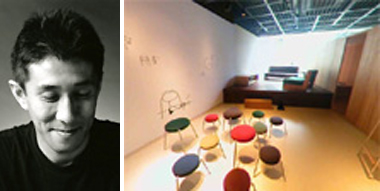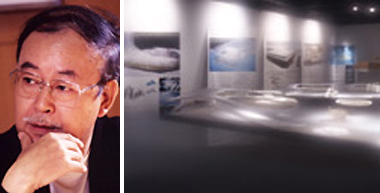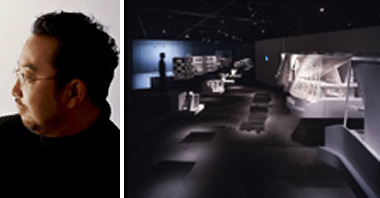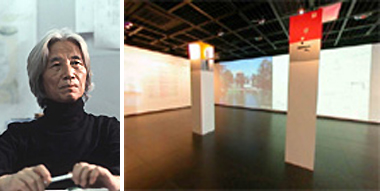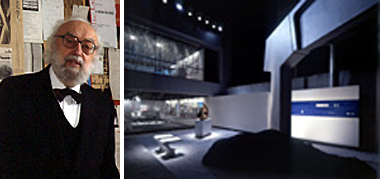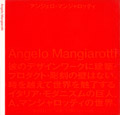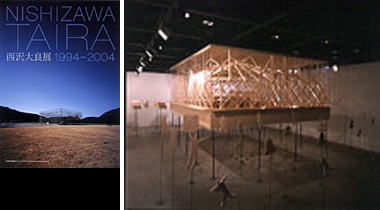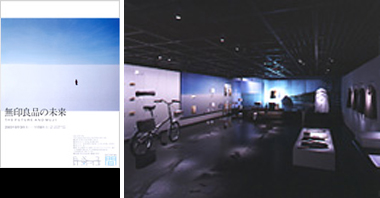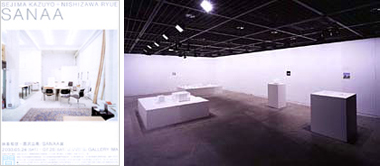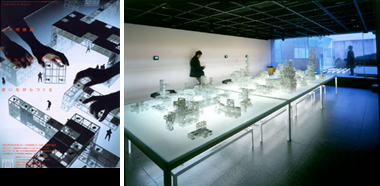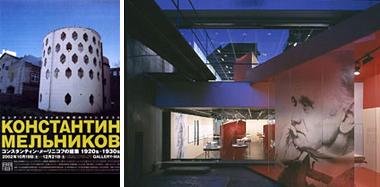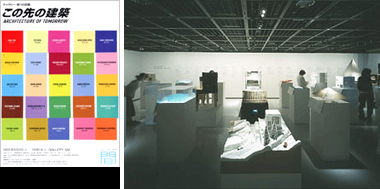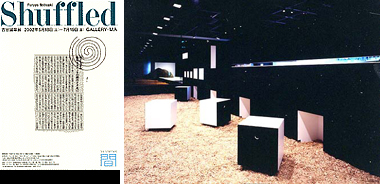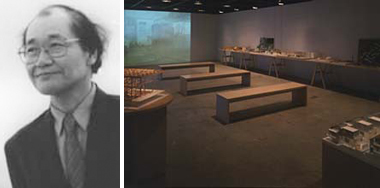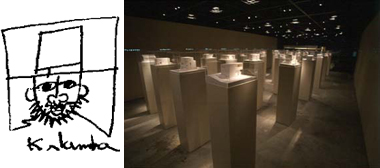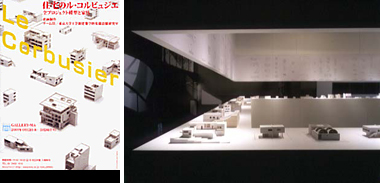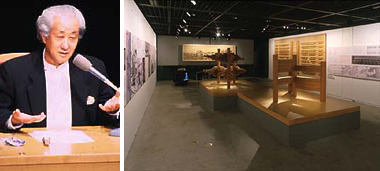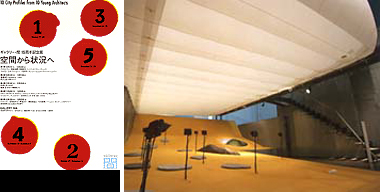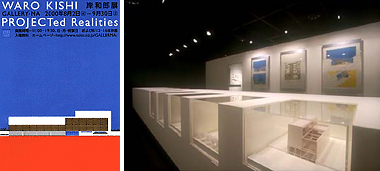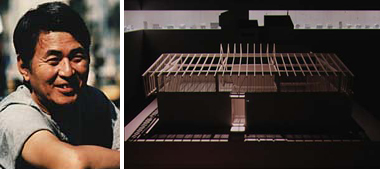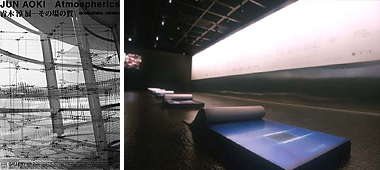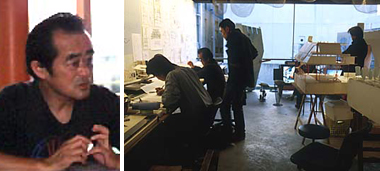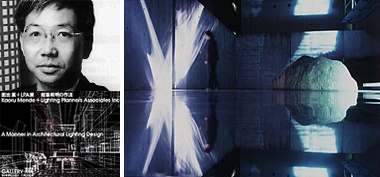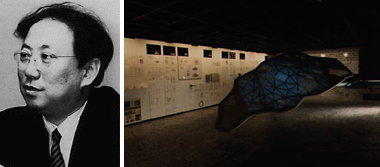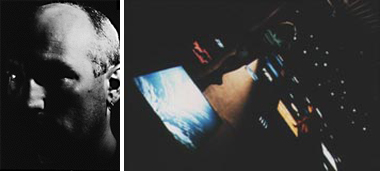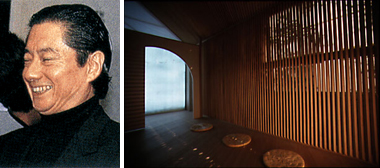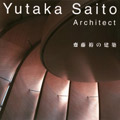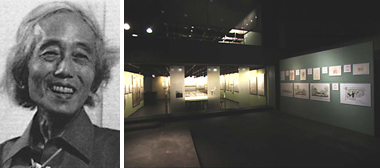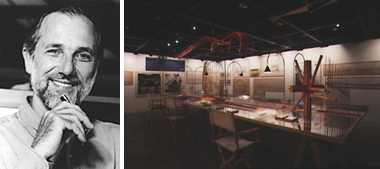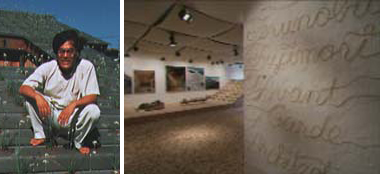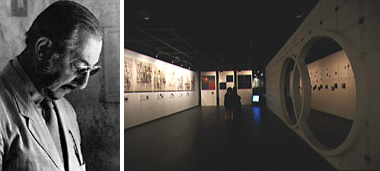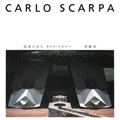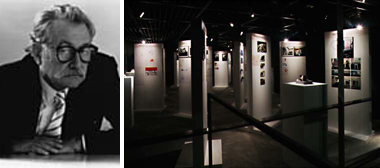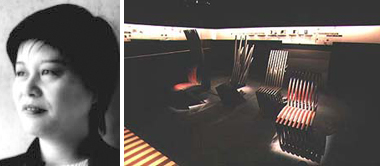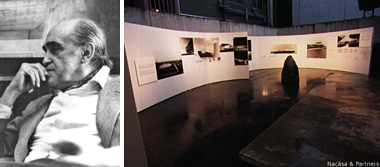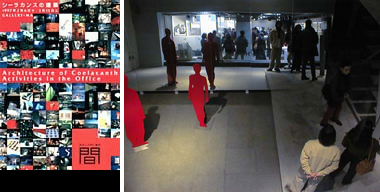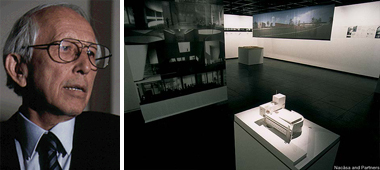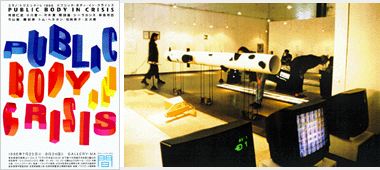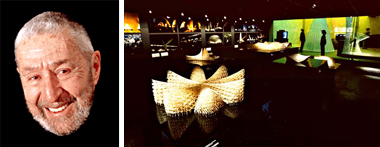- ExhibitionsTOTO GALLERY·MA
- Upcoming Exhibitions
- Past Exhibitions
- ExhibitionsExternal Locations
- Current Exhibitions
- Upcoming Exhibitions
- Past Exhibitions
- Lectures
- Upcoming Lectures
- Past Lectures
- Visitor Information
- Directions
- Gallery Infomation
- Museum Shop
- Bookshop TOTO
Cultural Activities
TOTO GALLERY·MA
TOTO Publishing
Bookshop TOTO
Past Exhibitions
December 8, 2005―February 25, 2006
Supervisors: Kazuhiro Kojima, Manabu Chiba
Project Collaborators: Takeshi Ishido, Satoru Komaki, Masayuki Fuchigami
Project Collaborators: Takeshi Ishido, Satoru Komaki, Masayuki Fuchigami
To mark its 20th anniversary, GALLERY·MA is holding an exhibition and lectures and issuing an accompanying commemorative publication. The house has long been regarded as the origin of architecture.
September 15―November 12, 2005
Exhibitor: Makoto Koizumi
In this exhibition, I hope that by bringing together “tools” born out of such feelings and re-editing them, I will be able to communicate to viewers the relationships surrounding the tools. The title of the exhibition, “KuRaSiGoTo”, is a portmanteau word made from kurashi (life), shigoto (work) and koto (circumstance)—three elements of everyday life. I think of it as suggesting both the cumulative effect of the work I have done designing tools for everyday life and the direction of my future activities.—Makoto Koizumi
June 1―July 30, 2005
Exhibitor: Mutsuro Sasaki
The shape design techniques I am advocating are the Sensitivity Analysis method and the Evolutionary Structure Optimization method. These involve generating rational structural shapes within a computer by using the principles of evolution and self-organization of living creatures from an engineering standpoint. I am currently experimenting with the initial applications of these methods to create new architectural structures. One example of their practical application is in Free-curved Surface Structures, and another is in Flux Structures.—Mutsuro Sasaki
March 9―May 14, 2005
Exhibitor: Hitoshi Abe
The essential forms (wall/surface typologies) of six projects have here been sliced into fragments. Detached from program, texture, scale, and environment, these fragments of architecture have been arrayed to generate a new space for visitors. This exhibiton is not confined to simulation and representation, but is a place for direct dialogue between body and form.—Hitoshi Abe
December 2, 2004―February 19, 2005
Exhibitor: Hiroshi Hara
In the end of the year 2003, the was built in Montevideo, the capital city of Uruguay, South America. It was then opened and displayed for many people living in the city. This has two meanings. Firstly, it is a house, which the dwellers can build by themselves. This is a small message for the overflowing people in the city without a place to live, which is happening all round the world. Secondly, this challenge envisions the .—Hiroshi Hara
September 10―November 13, 2004
Exhibitor: Angelo Mangiarotti
Co-sponsor: Angelo Mangiarotti Associates
Co-sponsor: Angelo Mangiarotti Associates
GALLERY·MA is presenting an exhibition by Angelo Mangiarotti, a Milan-based architect who has been engaged in wide-ranging creative activity in the fields of architecture, design, and sculpture for about half a century. Please take this opportunity to enjoy the modern creativity of Italy, the kingdom of design, through the large number of works brought from Mangiarotti’s studio in Milan, actual-size models made by the precast method, an interview video, and other materials.
May 22―July 24, 2004
Exhibitor: Taira Nishizawa
As an architect working in a place that repeatedly constructed and destroyed buildings to the very end of the twentieth century, I decided to compile in a single volume and to exhibit ideas that would not have emerged had I not been engaged in actual practice.—Taira Nishizawa
February 28―May 1, 2004
Exhibitors: Seung, H-Sang, Yung Ho Chang
Direction: Shin Muramatsu
Direction: Shin Muramatsu
The traditionally distinctive architectural worlds in this region, with more than two thousand years of history, are finally coming together as one. What connects Seung H-Sang from Seoul and Yung Ho Chang from Beijing is the fact that each represents most actively this emerging common East Asian architectural sphere. These two architects, who are marked by a mobile stance and individual talents that go beyond national boundaries, as well as by the long history of their respective architectural cultures flowing through their bodies, met in Osaka, collaborated in Beijing and Seoul, and now meet here again in Tokyo.—Shin Muramatsu
November 22, 2003―February 7, 2004
Exhibitor: Teiichi Takahashi
I believe that face-to-face encounters between those who create works of architecture and all those who have anything to do with those works have been necessary in all ages to forge close ties between architecture on the one hand and people and society on the other. I hope to those beliefs, even as I reflect on, and feel some small measure of satisfaction with respect to, the works presented in this volume.—Teiichi Takahashi
September 13―November 8, 2003
The goal of MUJI has continued to be the provision of basic, universal products for everyday life. There has been no change in its philosophy, which is rooted in the aesthetic of Japanese life and places value on fundamentals. In 2003 MUJI began to take that idea overseas. This exhibition is both a confirmation of MUJI’s commitment to its basic philosophy and a presentation of its new vision.
May 24―July 26, 2003
Exhibitors: Kazuyo Sejima, Ryue Nishizawa
SANAA’s entire body of work since it began its activites in 1995 will be published in one book; new projects currently underway will be introduced in an exhibition.
February 15―April 26, 2003
Exhibitor: Riken Yamamoto
When you try to create a building, you begin to see things. For example, the people who will use or manage the building, the local residents and the character of the locality. Those things are by no means obvious to you from the start. You do not know in advance what the people and the place for which you are trying to create a building are like. Those things become apparent to you only through the relationship they may have to the building. I think that is generally the case.—Riken Yamamoto
October 19―December 21, 2002
Direction and Space Design: Rishat Mullagildin
Melnikov’s representative works were built in an era after the socialist revolution when forms overturning established architectural principles were being created at an unprecedented rate in the Soviet Union. However, he was far in advance of the trend of the period, formally and conceptually. His works were always innovative and original.—Rishat Mullagildin
September 3―October 5, 2002
Exhibitors: Jun Aoki, Aterier Bow-Wow, Hitoshi Abe, Osamu Ishiyama, Arata Isozaki, Toyo Ito, Waro Kishi, Kengo Kuma, Kazuhiro Kojima/C+A, Kazuo Shinohara, Kazuyo Sejima, Masashi Sogabe, Manabu Chiba, Design Neuob, Hiroshi Naito, Ryue Nishizawa, Itsuko Hasegawa, Hiroshi Hara, Sou Fujimoto, Terunobu Fujimori, Hironori Matsubara, Satoru Yamashiro, Riken Yamamoto, Yasutaka Yoshimura
GALLERY·MA created a place where architects of different generations, from those in their 30s to those in their 70s, could come together and think about the architecture of tomorrow. Trends develop so rapidly today that there is little time or opportunity for members of different generations to share their views; this was an attempt to reexamine our awareness of the issues within a larger framework.
May 18―July 19, 2002
Exhibitor: Nobuaki Furuya
Architecture is of value to me as a framework through which to consider the world. The construction of architecture provides an opportunity to observe society, encounter people and understand nature. In addition to presenting scattered fragmenary notes collected from various sources, I hope to indicate here a process for generating architecture.—Nobuaki Furuya
February 23―April 27, 2002
Exhibitor: Koh Kitayama
A work of architecture is a point of singularity in the sea of circumstances prevailing today. A different interpretation of the situation can lead to the conception of a new relationship between human beings and space in that small point of singularity called architecture. A series of points of singularity may even be able to alter our perception of a situation that seems unalterable.—Koh Kitayama
November 16, 2001―February 2, 2002
Exhibitor: Kazunari Sakamoto
I have come to think that my desire is to free the space of architecture from several frames. It’s also that I have come to seek a space of freedom that has not yet been seen. This type of space will release our bodies and spirits from various binds, and make possible its own communication to the world. This space, however, is not within a special place or a special time. I have come to believe it is a place within the continuation of ordinary time.—Kazunari Sakamoto
June 9―August 10, 2001
Exhibitor: Kazuhiko Namba
The word “box” usually conjures images of closure. However, to me a box is a primary place grown out from a space where there was nothing. To make space into a building, we must utilize some kind of substance to construct a box. To turn box into a place, the number of substances should be kept to a minimum, and what substances there are should be used effectively. My series of the Box-Houses began as an attempt to achieve that objective.—Kazuhiko Namba
April 12―May 26, 2001
Planning and Producition: Team Ⅲ/Tadao Ando Laboratory, Department of Architecture, Graduate School of Engineering, the University of Tokyo
Direction: Tadao Ando, Manabu Chiba
Direction: Tadao Ando, Manabu Chiba
This project examines Le Corbusier through his houses. Widely recognized as the greatest architect of the twentieth century, Le Corbusier engaged in a broad range of creative activities—city planning, achitecture, painting, sculpture, writing and editing—but had an abiding interest in houses. The exhibition is an attempt to get as close as possible to the real Le Corbusier as opposed to the main about whom so much has already been said and written.—Team Ⅲ
January 20―March 24, 2001
Exhibitor: Arata Isozaki
One day, I realized that throughout the world unbuilt projects have become the sole subject of discussion among architectural historians. Paradoxically, unbuilt projects—projects that are unbuilt, that are never expected to be built, that are not intended to be built or that in no way can be built—have come to consitute architectural history.—Arata Isozaki
October 17―December 23, 2000
Direction: Hitoshi Abe, Taro Igarashi, Masashi Sogabe, Manabu Chiba
1st: Void | Oct. 17–28, 2000
Atelier Bow-Wow/Yoshiharu Tsukamoto+Momoyo Kaijima: Pet Architecture Project
Facter N Associates/Manabu Chiba+Nancy Finley: Renewal of “Urban Void”
2nd: Atmosphere | Oct. 31–Nov. 11, 2000
Shuhei Endo: Rooftecture/BUNYUUTAI
Ryue Nishizawa: Atmosphere
3rd: Agglomeration | Nov.14–25, 2000
Hitoshi Abe+Yasuaki Onoda: 10,000
Katsu Umebayashi: Reconsidering the pooblemations of housing
4th: Hybrid | Nov. 28–Dec. 9, 2000
Klein Dytham architecture/Astrid Klein+Mark Dytham: DELUXE TOWER
Matsuoka Wang Architects/Kyoko Matsuoka+Steven Tachun Wang: LINE→STAIN
5th: Geography | Dec. 12–23, 2000
MIKAN/Kiwako Kamo+Yosuke Kumakura+Masashi Sogabe+Masayoshi Takeuchi+Manuel Tardits: City Golf
Katsuhiro Miyamoto: dis-location
1st: Void | Oct. 17–28, 2000
Atelier Bow-Wow/Yoshiharu Tsukamoto+Momoyo Kaijima: Pet Architecture Project
Facter N Associates/Manabu Chiba+Nancy Finley: Renewal of “Urban Void”
2nd: Atmosphere | Oct. 31–Nov. 11, 2000
Shuhei Endo: Rooftecture/BUNYUUTAI
Ryue Nishizawa: Atmosphere
3rd: Agglomeration | Nov.14–25, 2000
Hitoshi Abe+Yasuaki Onoda: 10,000
Katsu Umebayashi: Reconsidering the pooblemations of housing
4th: Hybrid | Nov. 28–Dec. 9, 2000
Klein Dytham architecture/Astrid Klein+Mark Dytham: DELUXE TOWER
Matsuoka Wang Architects/Kyoko Matsuoka+Steven Tachun Wang: LINE→STAIN
5th: Geography | Dec. 12–23, 2000
MIKAN/Kiwako Kamo+Yosuke Kumakura+Masashi Sogabe+Masayoshi Takeuchi+Manuel Tardits: City Golf
Katsuhiro Miyamoto: dis-location
Architects born in the 1960s came to the forefront of the architectural scene in the period following the bursting of Japan’s bubble economy in the 1990s. Since then, they have been demonstrating original methods of design and styles of activites. This exhibition presents a surging architectural wave raised concurrently by 10 units of young architects.—Taro Igarashi
August 2―September 30, 2000
Exhibitor: Waro Kishi
Architecture does indeed have a certain dimension that is expressible in a gallery, that is, an aspect that can be expressed on an abstract level. That is why we have the exhibition format in the first plece. However, architecture has another aspect grounded in reality. In coming into being, architecture responds to diverse conditions; e.g. site, society, economy and culture.—Waro Kishi
May 20―July 15, 2000
Direction: Makoto Ueda, Hiroshi Naito, Yoshifumi Nakamura, Kenichi Yamazaki
This exhibition focuses on Miyawaki’s housing projects, which were always the center of his prolific activity, and exhibits eight representative works including “Matsukawa Box”, “Funabashi Box”, and “Blue Box”.
March 3―April 28, 2000
Exhibitor: Jun Aoki
I’m interested in composition. But I don’t wish to design actual buildings for the sake of “expressing” the composition. I’m interested in structure. But I don’t wish to express structure.—Jun Aoki
December 4, 1999―February 19, 2000
Phase 1: Dec. 4–22, 1999 | Recreation
Phase 2: Jan. 11–29, 2000 | Movement
Phase 3: Feb. 1–19, 2000 | Chaos
Exhibitor: Osamu Ishiyama
Phase 2: Jan. 11–29, 2000 | Movement
Phase 3: Feb. 1–19, 2000 | Chaos
Exhibitor: Osamu Ishiyama
“Open Technology”, the underlying theme of the exhibiton, is, simply put, the idea that a new world is out there. We can catch a glimpse of that world if we examine the implications of gardening, a currently fashionable pastime. If we can think about and create our own garden, then why can’t we think about and create our own environments?—Osamu Ishiyama
September 25―November 20, 1999
Exhibitor: Kaoru Mende
“Manners” are necessary to lay the trap of comfortable air using light. We learn manners in architectural lighting design from nature, from historical architecture and from the techniques of great architects. Through this exhibition I decided to fully disclose the limitlessly liberal creative energy of lighting design and the somewhat more limited but profound craftsmanship of light.—Kaoru Mende
July 2―September 4, 1999
Exhibitor: Chiaki Arai
“Architecture for arousing”, that is, architecture that rouses or inspirits, must be part of a larger cultural activity prior to and after cnstruction. It is necessary to lift people’s spirits, that is, to make people feel that the building is their own.
March 5―April 24, 1999
Exhibitor: Shigeru Ban
The Japanese Pavilion for the World Exposition Expo 2000 Hannover, Germany, is my current project. Here, we introduce various attempts made during the design and construction processes, including some new developments mainly for the Japanese Pavilion, Expo 2000 Hannover and some other ongoing projects.—Shigeru Ban
December 5, 1998―February 20, 1999
Exhibitor: Yann Kersalé
Yann Kersalé, a French artist, forcuses on light in his art and design projects. In this exhibition, the space is divided into three zones. Each of them represents, “past”, “present”, and “future”, and creates pageants of light along these themes.
September 19―November 14, 1998
Exhibitor: Yutaka Saito
There are wonderful sections that speak eloquently of space. My desire has long been to create works of architecture in which such sections appear. In this exhibition, I am presenting in plan and three-dimensional form a number of sections I have conceived.—Yutaka Saito
July 10―August 1, 1998
Fumitaka Nishizawa, the second head of Sakakura Associates, was a well-known architect who left behind many works. In addition to his activities as an architect, Nishizawa was also deeply interested in the relationship between traditional Japanese architecture and gardens.—Keisuke Fujii
April 25―June 27, 1998
Exhibitor: Renzo Piano
This exhibition is the Japanese stage of the world exhibition tour “Renzo Piano+Building Workshop—Out of the Blue”, a retrospective of the works of Renzo Piano. It reveals in full 4 works selected from the main collection.
February 13―April 4, 1998
Exhibitor: Terunobu Fujimori
Here I present all five of my works. Using materials collected from nature. I undertook these projects while reflecting on the question of the relationship between nature and artifact.—Terunobu Fujimori
November 11―December 20, 1997
Guest Curator: Franca Semi
Direction: Yutaka Saito
Direction: Yutaka Saito
This exhibiton introduces the Brion Cemetery. The photographic panels show the work in different seasons of the year. The exhibition also attempts to reveal the hidden essence of Scarpa’s architectural viewpoint, spatial method and perfectionistic approach to details.—Yutaka Saito
September 24―November 1, 1997
Exhibitor: Ettore Sottsass
The exhibition by the architect Ettore Sottsass at the GALLERY·MA in Tokyo, was divided into 2 sections: exhibited in the first section, at the ground floor of the Gallery, were 9 pieces of furniture designed by Sottsass in 1996 for the Gallery Mourmans of Knokke-Zoute, Belgium.
June 7―July 19, 1997
Exhibitor: Kazuko Fujie
I hope that not only representing form but everything including selection of materials and handmade details induces various movements of people through the all process of creation, which results in representing fresh scenery. —Kazuko Fujie
April 4―May 24, 1997
Exhibitor: Oscar Niemeyer
I am not attracted by straight angles. Nor by straight, head and inflexible lines created by man.
I am attracted by free-flowing, sensuous cueves.
—Oscar Niemeyer
I am attracted by free-flowing, sensuous cueves.
—Oscar Niemeyer
February 6―March 15, 1997
Exhibitor: Coelacanth (Yasuyuki Ito, Susumu Uno, Kazumi Kudo, Masao Koizumi, Kazuhiro Kojima, Mitsumasa Sampei, Maho Hiiro, Hiroshi Horiba)
“Coelacanth architects” centers around eight partners who design and conduct research activities individually, in teams, or together as a group. In order to convey a natural sense of how a diverse range of activities is carried out by multiple subjects, we have transferred the Coelacanth architects “Office” andplaced it on display.
November 20, 1996―January 18, 1997
Exhibitor: Fumihiko Maki
The present exhibition focuses on Fumihiko Maki’s truly current work. Along with numerous studio models, structure component models, drawings, and site photos, the exhibition delivers a report on the tension surrounding actual sites that have just been completed or are presently in progress.
September 11―October 26, 1996
Exhibitor: Neil M. Denari
For Denari, contemporary architecture exists within a society filled with a mixture of coded images that trancends the concrete “thing” itself. Denari seeks to discover the possibilities of architecture within such a society, as well as how architecture can be made to fuse with society. Denari offered one solution to these questions in the space of GALLERY·MA.
July 23―August 24, 1996
Exhibitors: Hitoshi Abe, Shinichi Ogawa, Atsushi Katagi, Kengo Kuma, Coelacanth Architects, Kazuyo Sejima, Kiyoshi Sey Takeyama, Norihiko Dan, Tom Heneghan, Matsuoka Wang Architects
GALLERY·MA is sponsoring an exhibition titled “Milan Triennale1996: Public Body in Crisis” to commemorate the participation of the Japan team in this year’s architectural and design festival “19th Milan Triennale” held in Milan.
May 17―June 22, 1996
Exhibitors: Eisaku Ushida, Kathryn Findlay
Usually when we walk around the city we hold a map of it in our minds framed by the memory of our own space. Each person has their individual image of the city based on that person’s psychological or physical experiences, consequently we walk around that city as if referring to some sort of personal navigational chart.
March 15―April 27, 1996
Direction: Yutaka Saito
Candela has taken the simple geometric shape of the HP shell and used it to introduce a dazzling array of variations into architecture. All of his works, including this enormous 60m×90m space, are constructed in four centimeter thick reinforced concrete.
Copyright © TOTO LTD. All Rights Reserved.







